This is an old revision of this page, as edited by AnnGWik (talk | contribs) at 02:22, 8 September 2024 (→List of rulers). The present address (URL) is a permanent link to this revision, which may differ significantly from the current revision.
Revision as of 02:22, 8 September 2024 by AnnGWik (talk | contribs) (→List of rulers)(diff) ← Previous revision | Latest revision (diff) | Newer revision → (diff) Royal dynasty in Mesopotamia First Dynasty of Ur(26th-25th century BCE)
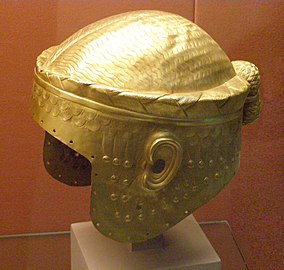 Golden helmet of Meskalamdug, possible founder of the First Dynasty of Ur, circa 2500 BCE.
Golden helmet of Meskalamdug, possible founder of the First Dynasty of Ur, circa 2500 BCE.

The First Dynasty of Ur was a 26th-25th century BCE dynasty of rulers of the city of Ur in ancient Sumer. It is part of the Early Dynastic period III of the history of Mesopotamia. It was preceded by the earlier First Dynasty of Kish and the First Dynasty of Uruk.
Rule


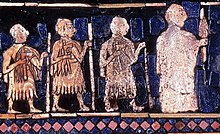
According to the Sumerian King List, the final ruler of the First Dynasty of Uruk Lugal-kitun was overthrown by Mesannepada of Ur. There were then four kings in the First Dynasty of Ur: Mesannepada, Mes-kiagnuna, Elulu, and Balulu. Two other kings earlier than Mes-Anepada are known from other sources, namely Mes-kalam-du and A-Kalam-du. It would seem that Mes-Anepada was the son of Mes-kalam-du, according to the inscription found on a bead in Mari, and Mes-kalam-du was the founder of the dynasty. A probable Queen Puabi is also known from her lavish tomb at the Royal Cemetery at Ur. The First Dynasty of Ur had extensive influence over the area of Sumer, and apparently led a union of south Mesopotamian polities.
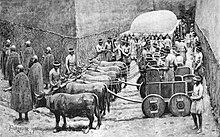
Ethnicity and language
Like other Sumerians, the people of Ur were a non-Semitic people who may have come from the east circa 3300 BCE, and spoke a language isolate.
International trade
Main articles: Indus-Mesopotamia relations and Egypt-Mesopotamia relations
The artifacts found in the royal tombs of the dynasty show that foreign trade was particularly active during this period, with many materials coming from foreign lands, such as Carnelian likely coming from the Indus or Iran, Lapis Lazuli from the Badakhshan area of Afghanistan, silver from Turkey, copper from Oman, and gold from several locations such as Egypt, Nubia, Turkey or Iran. Carnelian beads from the Indus were found in Ur tombs dating to 2600-2450, in an example of Indus-Mesopotamia relations. In particular, carnelian beads with an etched design in white were probably imported from the Indus Valley, and made according to a technique developed by the Harappans. These materials were used into the manufacture of beautiful objects in the workshops of Ur.

The Ur I dynasty had enormous wealth as shown by the lavishness of its tombs. This was probably due to the fact that Ur acted as the main harbour for trade with India, which put her in a strategic position to import and trade vast quantities of gold, carnelian or lapis lazuli. In comparison, the burials of the kings of Kish were much less lavish. High-prowed Sumerian ships may have traveled as far as Meluhha, thought to be the Indus region, for trade.
Demise
According to the Sumerian King List, the First Dynasty of Ur was finally defeated, and power went to the Elamite Awan dynasty. The Sumerian king Eannatum (c.2500–2400 BCE) of Lagash, then came to dominate the whole region, and established one of the first verifiable empires in history.
The power of Ur would only revive a few centuries later with the Third Dynasty of Ur.
List of rulers
| # | Depiction | Ruler | Succession | Epithet | Approx. dates | Notes |
|---|---|---|---|---|---|---|
| Early Dynastic IIIa period (c. 2600 – c. 2500 BC) | ||||||
| Predynastic Ur (c. 2600 – c. 2500 BC) | ||||||

|
A-Imdugud 𒀀𒀭𒅎𒂂 |
fl. c. 2600 BC |
| |||

|
Ur-Pabilsag 𒌨𒀭𒉺𒉋𒊕 |
d. c. 2550 BC | ||||
| # | Depiction | Ruler | Succession | Epithet | Approx. dates | Notes |
| Early Dynastic IIIb period (c. 2500 – c. 2350 BC) | ||||||

|
Akalamdug 𒀀𒌦𒄭 |
reigned c. 2600, c. 2500 BC |
| |||

|
Meskalamdug 𒈩𒌦𒄭 |
r. c. 2600, c. 2500 BC |
| |||

|
Puabi 𒅤𒀜 |
m. c. 2550, c. 2500 BC to Meskalamdug (?) |
| |||
— SKL | ||||||

|
Mesannepada 𒈩𒀭𒉌𒅆𒊒𒁕 |
r. c. 2500 BC (80 years) |
| |||

|
Meskiagnun 𒈩𒆠𒉘𒉣 |
r. c. 2485 – c. 2450 BC (36 years) |
| |||

|
Elulu 𒂊𒇻𒇻 |
r. c. 2455, c. 2445, c. 2350 BC (25 years) |
| |||

|
Balulu 𒁀𒇻𒇻 |
Uncertain (36 years) |
| |||
| ||||||

|
Enshakushanna 𒂗𒊮𒊨𒀭𒈾 |
r. c. 2440, c. 2430, c. 2400, c. 2350 BC (60 years) |
| |||

|
Lugal-kinishe-dudu 𒈗𒆠𒉌𒂠𒌌𒌌 |
r. c. 2430, c. 2400 BC (120 years) |
| |||

|
Lugal-kisal-si 𒈗𒆦𒋛 |
r. c. 2400 BC |
| |||
| A'annepada 𒀀𒀭𒉌𒅆𒊒𒁕 |
Uncertain; this ruler may have r. c. 2500 – c. 2350 BC sometime during the EDIIIb period |
| ||||
| # | Depiction | Ruler | Succession | Epithet | Approx. dates | Notes |
| Proto-Imperial period (c. 2350 – c. 2112 BC) | ||||||
| Lunanna | Uncertain; this ruler may have r. c. 2350 – c. 2112 BC sometime during the Proto-Imperial period |
| ||||
Sumerian King List
Only the final kings of the First Dynasty of Ur, from Mesannepada to Balulu and possibly 4 unnamed kings, are mentioned in the Sumerian King List:
"... Uruk with weapons was struck down, the kingship to Ur was carried off. In Ur Mesannepada was king, 80 years he ruled; Mesh-ki-ang-Nanna, son of Mesannepada, was king, 36 years he ruled; Elulu, 25 years he ruled; Balulu, 36 years he ruled; 4 kings, the years: 171(?) they ruled. Ur with weapons was struck down; the kingship to Awan was carried off.
— Sumerian King List, 137-147.
Artifacts
Main article: Royal Cemetery of UrThe Royal Cemetery of Ur held the tombs of several rulers of the First Dynasty of Ur. The tombs are particularly lavish, and testify to the wealth of the First Dynasty of Ur. One of the most famous tombs is that of Queen Puabi.
-
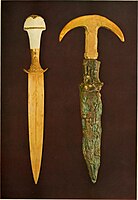 A gold dagger and a dagger with a gold-plated handle, Ur excavations (1900).
A gold dagger and a dagger with a gold-plated handle, Ur excavations (1900).
-
Reconstructed Sumerian headgear necklaces found in the tomb of Puabi, housed at the British Museum
-
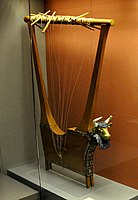 Queen's Lyre, one of the Lyres of Ur, Ur Royal Cemetery.
Queen's Lyre, one of the Lyres of Ur, Ur Royal Cemetery.
-
 Cylinder seal of Queen Puabi, found in her tomb. Inscription 𒅤𒀀𒉿 𒊩𒌆Pu-A-Bi-Nin "Queen Puabi". The last word "𒊩𒌆" can either be pronounced Nin “lady”, or Eresh “queen”.
Cylinder seal of Queen Puabi, found in her tomb. Inscription 𒅤𒀀𒉿 𒊩𒌆Pu-A-Bi-Nin "Queen Puabi". The last word "𒊩𒌆" can either be pronounced Nin “lady”, or Eresh “queen”.
-
 The Standard of Ur
The Standard of Ur
-
 Ram in a Thicket
Ram in a Thicket
-
Lyre of a Bull's Head from Queen Puabi's tomb. (British Museum)
-
 Nacre plate with anthropomorphic animals, circa 2600 BCE
Nacre plate with anthropomorphic animals, circa 2600 BCE
See also
References
- The Cambridge Ancient History. Cambridge University Press. 1970. p. 228. ISBN 9780521070515.
- Encyclopedia of the Peoples of Africa and the Middle East. Infobase Publishing. 2009. p. 664. ISBN 9781438126760.
- ^ Frayne, Douglas (2008). Pre-Sargonic Period: Early Periods, Volume 1 (2700-2350 BC). University of Toronto Press. pp. 901–902. ISBN 9781442690479.
- ^ Diakonoff, I. M. (2013). Early Antiquity. University of Chicago Press. pp. 78–79. ISBN 9780226144672.
- "The Sumerians, a non-Semitic people who perhaps came from the east" in Curtis, Adrian (2009). Oxford Bible Atlas. Oxford University Press. p. 16. ISBN 9780191623325.. Mention of Gen 11:2 "And as people migrated from the east, they found a plain in the land of Shinar and settled there." (English Standard Version)
- Bromiley, Geoffrey W. (1979). The International Standard Bible Encyclopedia. Wm. B. Eerdmans Publishing. p. 392. ISBN 9780802837813.
- ^ British Museum notice: "Gold and carnelians beads. The two beads etched with patterns in white were probably imported from the Indus Valley. They were made by a technique developed by the Harappan civilization" Photograph of the necklace in question
- ^ British Museum notice "Grave goods from Ur"
- McIntosh, Jane (2008). The Ancient Indus Valley: New Perspectives. ABC-CLIO. pp. 182–190. ISBN 9781576079072.
- "Then Urim was defeated and the kingship was taken to Awan." in Kriwaczek, Paul (2014). Babylon: Mesopotamia and the Birth of Civilization. Atlantic Books. p. 136. ISBN 9781782395676.
- ^ Incorporated, Facts On File (2009). Encyclopedia of the Peoples of Africa and the Middle East. Infobase Publishing. p. 664. ISBN 9781438126760.
- Knapp, Arthur Bernard (1988). The history and culture of ancient Western Asia and Egypt. Wadsworth. p. 92. ISBN 9780534106454.
- Woolley, Leonard; Hall, Henry; Legrain, L. (1900). Ur excavations (Report). Vol. II. Trustees of the British Museum and of the Museum of the University of Pennsylvania by the aid of a grant from the Carnegie Corporation of New York. ISBN 9780598629883. Archived from the original on 2010-07-01.
- Aruz, J.; Wallenfels, R. (2003). Art of the First Cities: The Third Millennium B.C. from the Mediterranean to the Indus. Metropolitan Museum of Art Series. New York: Metropolitan Museum of Art. ISBN 9780300098839.
- ^ Marchesi, Gianni (January 2015). Sallaberger, Walther; Schrakamp, Ingo (eds.). "Toward a Chronology of Early Dynastic Rulers in Mesopotamia". History and Philology (ARCANE 3; Turnhout): 139–156.
- "CDLI-Found Texts". cdli.ucla.edu.
- "CDLI-Found Texts". cdli.ucla.edu.
- British Museum notice WA 121544
- Crawford, Harriet (2013). The Sumerian World. Routledge. p. 622. ISBN 9781136219115.
- Anthropology, University of Pennsylvania Museum of Archaeology and; Hansen, Donald P.; Pittman, Holly (1998). Treasures from the Royal Tombs of Ur. UPenn Museum of Archaeology. p. 78. ISBN 9780924171550.
- James, Sharon L.; Dillon, Sheila (2015). A Companion to Women in the Ancient World. John Wiley & Sons. p. 13. ISBN 9781119025542.












